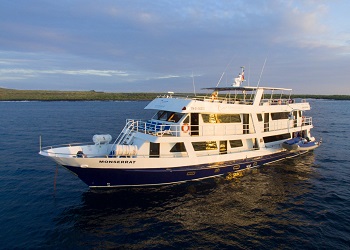Darwin Itinerary Discovery- 4 Days
ITINERARY D - 4 DAYS
MONDAY
AM: Baltra Arrival and Transfer to the boat
PM: Santa Cruz: Twins Craters / Highlands (HK)
TUESDAY
AM: Santiago: Egas Port (HK/SN)
PM: Santiago: Espumilla Beach / Bucaneer's cove (HK/SN)
WEDNESDAY
AM: Bartolome (HK/SN)
PM: Santiago: Sullivan Bay (HK/SN)
THURSDAY
AM: Bachas Beach (HK/PR)
The tour ends in Seymour. You must take the Lobito bus in the direction of Baltra Airport.
HK: HIKE / SN: SNORKEL / PR: PANGA RIDE / KY: KAYAK /
PB: PADDLE BOARD
DAY 1: MONDAY
AM: BALTRA ARRIVAL AND TRANSFER TO THE BOAT
After landing in Santa Cruz, go through an inspection point to prevent the introduction of foreign plants and animals.
Your guide will meet you at the airport, help with your luggage, and take you to the bus for the ferry across the Itabaca Channel.
PM: SANTA CRUZ: TWINS CRATERS / HIGHLANDS
After shopping in Puerto Ayora and lunch on the boat (guests may dine in town if they desire), you’ll explore the highlands or “parte alta” of the island, which is a moisture-rich area with fertile volcanic soils. You’ll learn about the vegetation and animal life of this zone, often strikingly different than that found at lower elevations and our best opportunity to find the famous giant tortoises in their natural habitat. Darwin’s Finches, Yellow Warblers, and other land birds will fly in and out of the moss-covered trees. From this high vantage point you’ll be treated to beautiful views of the island.
In the late afternoon you’ll return to town. For those who wish to check out the nightlife, this is your chance; the boat will be docked in port most of the night.
DAY 2: TUESDAY
AM: SANTIAGO: EGAS PORT
James Bay is a black sand beach located on the west side of James Bay and northwest of Santiago Island. South of the beach is Sugarloaf Volcano, which has deposits of volcanic tuff, the same that helped the formation of the black sand beach. El Cráter is just north of this site, it has a saltwater lagoon, which during the summer dry season becomes a salt mine. Between 1928 and 1930 was the first exploitation of salt; but the efforts did not last long. Then again in 1964 a new attempt was made that lasted for some time. After lunch on board we’ll navigate to our next destination, .
AM: SANTIAGO: ESPUMILLA BEACH - BUCCANEER COVE
Breakfast service. Wet landing Espumilla Beach. Panga boat ride to Buccaneer Cove. Deep water snorkeling.
The excursion begins just a short distance beyond the tide pools and heads to the fur seal grotto. Fur seals and sea lions can be seen swimming in the rocky lava ringed pools. This may be the only opportunity visitors have to see and swim with fur seals.
Fur seals were once hunted to near extinction for their coats. The Galapagos Fur Seal is the smallest of the fur seals found in the southern hemisphere, now compare in numbers with the sea lions. During the day they hide from the hot equatorial sun in shelves or caves of the rocky lava cliffs. At night they feed on squid and fish avoiding the sharks, which are their natural predator.
The crystal clear water, volcanic bridges, fur seals and sea lions make this a magnificent place for swimming and snorkeling.
Along the way those with a watchful eye may spot a variety of Darwin finches or a vermilion fly catcher. Once back at the beach visitors may have the chance to swim or snorkel time permitting.
DAY 3: WEDNESDAY
AM: BARTOLOME ISLAND
Bartolome Island, which at its highest point is 114 meters, is one of the most photographed vistas in the archipelago. This island is quite young and quite volcanic, therefore, it's relatively unpopulated; only a small handful of die-hard plant and animal
species have survived long enough to call this lava-land home.
PM: SANTIAGO: SULLIVAN BAY
After the visit to Bartolome Island you’ll visit nearby Sullivan Bay. At the turn of the century a huge lava flow spilled right down to the sea and today you can stroll across this black volcanic expanse, admiring its time-frozen ripples, bubbles and ropes.
DAY 4: THURSDAY
PM: SANTA CRUZ: BACHAS BEACH / TRANSFER TO THE AIRPORT
Navigation to Bachas Beach in Santa Cruz.
Wet landing. Nature walk.
The name is “Spanglish” for 'barges' which were wrecked offshore during the World War II. g. The saltwater lagoon behind often has great blue herons and small waders such as sander lings and semi‐palmated plovers. Both beaches are nesting areas for green sea turtles, which leave tracks in the sand to the back of the beach, especially from November to February. The beach offers ample space one can explore at leisure.







